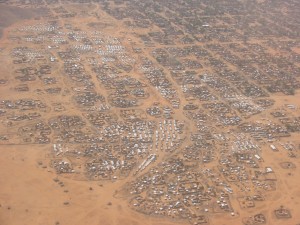I had an unexpected surprise in El Fasher at an UNMIS meeting, when a human rights protection officer I met with turned out to be a former student. He organized a small dinner party for our last night in Darfur, full of Indian delicacies that he had brought back from his most recent trip home to visit family. It was an evening filled with fun and a great deal of sentiment, as I learned about Sadiq’s unique work supporting early recovery programs with the women of Darfur and the other activities he had undertaken with peacekeeping forces over the last four years. Sadiq promised to take me to an IDP camp the following morning, just before I was scheduled to fly back to Khartoum.
The camp is called Abu-Shouk, and is located on the outskirts of the town. In fact, there are two camps adjacent to the town, with a total of around 100,000 in ternally displaced persons (IDPs). I had seen these settlements from the air when landing in El Fasher, but the endless vista of mud and thatch houses in their private compounds brought home the vastness of the resettlement. Moreover, the structures did not look temporary. People seemed to have settled in.
ternally displaced persons (IDPs). I had seen these settlements from the air when landing in El Fasher, but the endless vista of mud and thatch houses in their private compounds brought home the vastness of the resettlement. Moreover, the structures did not look temporary. People seemed to have settled in.
As I entered the camp I saw an area where bricks were being prepared and then fired – a booming enterprise among IDPs. Huge craters pocketed nearby areas, where sand had been removed to prepare the bricks. There were also fenced-in enclosures where large amounts of livestock were kept and people going about their daily business, much like they appeared to in downtown Fasher.
This particular camp received assistance from the International Rescue Committee (IRC), which had a large tent that served as a women’s health center. Sadiq drove me quickly to some service centers that were available in Abu-Shouk, including a Justice and Confidence Centers (alternative dispute resolution and paralegal services) and a CHF community center, where I saw the fuel-efficient stoves I had read about, a group of children having a lesson, a room where women gather to make handicrafts in order to generate some small income, and an enthusiastic game of volleyball being carried out by some young women.
The visit was too short but it gave me some impressions, which my companion supplemented with details on camp life before driving me to the airport for my flight back to Khartoum. I left the camp with two stinging questions. The first was would these people ever be able to go home? The irony of successfully bringing in humanitarian assistance in such a crisis is that it creates a dependency that is difficult to break.
My second question concerned the invisible IDP camps, the ones in less secure and difficult-to-reach areas. There are whole sections of Darfur that are simply too dangerous for humanitarian agencies to travel to. If it’s too dangerous for outside help, how can it be for the people who live there all the time?
